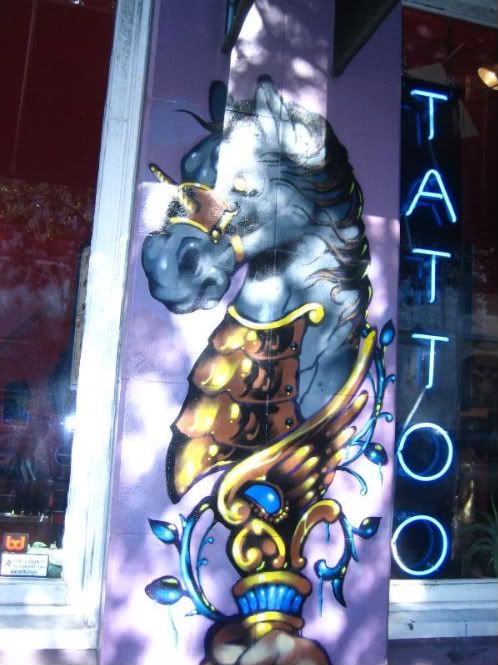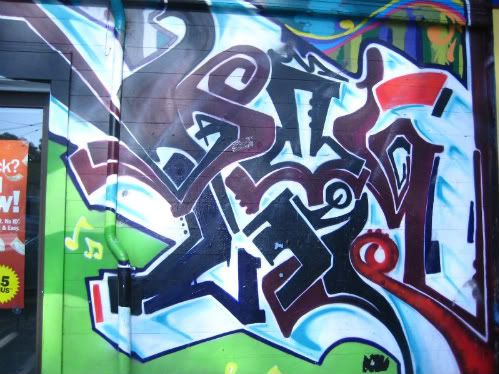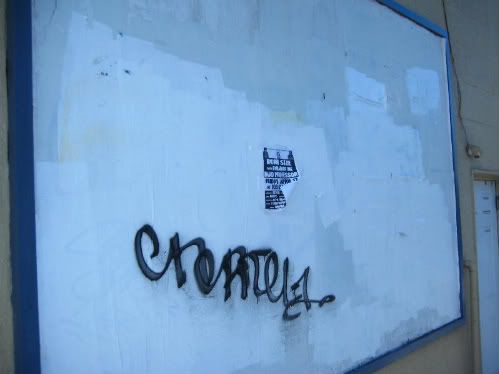
Tuesday, May 12, 2009
SFFD
So, today I was in my neighbor hood exploring the fire houses that respond to calls that are in the upper and lower Haight areas. I found out that the calls are divided between three different local fire stations: station 12, station 21 and station 6. Its crazy that there isnt like one central firehouse for the district and with the volume of calls they respond to you would think they would have a station right on haight street haha One of the firefighters that I talked to told me that so many of the calls that they respond to are dealing with the local haight street junkies and homeless people. When I was at station 6 they got a call for a heart attack down the street and it was cool to see how they are out at the drop of a dime and when they come back they are just so casual and ready for the next call. All the firefighters I met where extremely nice and welcoming which I feel is the general vibe of my hood.... hell, they even gave me milk and cookies!


Monday, April 27, 2009
Molotovs.
So, I have been spending a lot of time at the local bars in both the lower and upper Haight areas and I thought I would share a little about my favorite one so far- MOLOTOVS! The bar is located in the Lower Haight on Haight Street between Fillmore and Steiner. It is a small "dive bar" type that is good for grabbing a drink after work or partying hard on the weekends. They always have really good punk, metal, alternative or old school rock n roll playing and sometimes you can watch that really funny "manswers" show will you are in there. The bartenders are fast, drinks are cheap and STRONG! A few 4 dollar mixed drinks and you will be will on your way to toasted. There is also a lot of really interesting art work hanging on the walls that you can see... but you might need to use a flash light because it is normally pretty dark inside... aka be careful who you are flirting with because sometimes you will be shocked when they turn the lights on at last call! haha I was also told my a regular named Morgan Gessert that the "drink of choice" is Pabst which seems to be the same at all bars in the lower haight. Oh and if you have a dog this bar is perfect for you... they allow just about anyone to bring in any type of dog... hell, I even saw a dog drinking beer in there this past friday night!!!
Sunday, April 26, 2009
Graffiti.
As many of you know, I did my crime article on graffiti in the Haight. While I was doing my reporting, I walked from one end of Haight Street all the way to the other end. As I walked down the street I stopped at all the various graffiti along the way and took some pictures. Honestly, I was shocked by all the graffiti that is so artistic and done with such talent.
Here are some of the pictures I took:




(from the outside of soul patch tattoo shop)

(also soul patch)

(also soul patch)


(this one is insane! you can't even tell it is on a door, it looks like a real painting!)


(notice the "fuck pigs"... not really the smartest idea to tag if you don't wanna go to jail haha)



(this was actually the only real tagging i found)
and then there was one wall that really caught my attention...

See, the thing is that it is a blank wall and really what harm would it be if it was used to graffiti? I think it is time for San Francisco to get with the times and start a program so graffiti artists can legally show off their talent. Like in Venice Beach in SoCal... they have walls reserved for graffiti... and guess what? They probably don't have as big as a problem with graffiti as San Francisco currently does.
Here are some of the pictures I took:




(from the outside of soul patch tattoo shop)

(also soul patch)

(also soul patch)


(this one is insane! you can't even tell it is on a door, it looks like a real painting!)


(notice the "fuck pigs"... not really the smartest idea to tag if you don't wanna go to jail haha)



(this was actually the only real tagging i found)
and then there was one wall that really caught my attention...

See, the thing is that it is a blank wall and really what harm would it be if it was used to graffiti? I think it is time for San Francisco to get with the times and start a program so graffiti artists can legally show off their talent. Like in Venice Beach in SoCal... they have walls reserved for graffiti... and guess what? They probably don't have as big as a problem with graffiti as San Francisco currently does.
Monday, April 20, 2009
420
so today is april 20th and i wanted to take a few minutes to bitch about how stupid i think people are. why do people feel the need to smoke a bunch of weed on the particular day? first of all, weed is illegal and second of all, it is for dirty nasty hippes.
i think all the damn stoners need to go get a life and find something better to do with their lies tahn sit around and smoke weed. it is really unattractive and i refuse to take part of it.
and to all my friends who are going out smoking wee dtonight, forget you know me.
losers. haha
i think all the damn stoners need to go get a life and find something better to do with their lies tahn sit around and smoke weed. it is really unattractive and i refuse to take part of it.
and to all my friends who are going out smoking wee dtonight, forget you know me.
losers. haha
Thursday, April 16, 2009
There are two distinctly different neighborhoods on the opposite ends of Haight Street. One half still holds true to its counter-culture while the other half has created its very own young and refreshing reputation in recent years.
The Haight is located between the Panhandle and Hayes Valley in San Francisco. It’s known worldwide for its deep history, beautiful houses, unique shops, artistic style, and of course, the eccentric people who roam the block.
Beverly Ryan has lived in the Haight for 41 years. When she was in her early twenties she hopped on a bus in a small town outside of Chicago and headed out to join the excitement in the Haight during what is now known as the Summer of Love. She fell in love with the neighborhood instantly and hasn’t left since then.
“Haight was like a dream come true to the herds of people who flocked there in the 60s and still draws in excited crowds day after day,” Ryan said. “It never lost its touch.”
When Ryan was younger, her days were filled with acid, music and long hair. Nowadays she has the advantage of reminiscing of those days while enjoying the new generation of Haight Street locals, the growing number of tourists and the commercial changes around the Haight.
Today approximately 39,000 people live in the Haight. These residents are all packed into the blocks of colorful old Victorian houses.
The median housing price is $1,096,337, which may explain while the majority of homes are renter occupied units. The majority of residents are between the ages of 25 to 34, including a large population of students and young professionals, according to About.com.
On the street level of these homes residents and visitors can find a variety of local businesses. You can go search for old records at Amoeba Music, grab a slice of pizza at Escape From New York, get a quick trim at Blade Runners Salon, get tattooed at Mom’s Tattoo or dig through bins of old-fashion clothes at Buffalo Exchange.
“My favorite part of working on Haight Street is staring out the shop window and watching the different people stroll up and down the block,” said Eric Jones, a local tattoo artist. “The people here seem to have the most character in the city. From the crack heads in the park to the old hippies, we’ve got it all.”
There are many different forms of eye-catching art on Haight Street such as street performers, graffiti and musicians who trying to make a buck or two. These artists fill the street corners during the day and at nighttime disc jockeys, bands and art galleries pull people in. Popular nightclubs such as The Underground SF, Club Deluxe and Milk keep the evenings on Haight Street alive.
There are also several schools located on Haight Street such as William R. De Avila Elementary School and Aim High Academy Middle School. There is a health clinic, Cole Street Clinic, located on the corner of Haight Street and Cole Street.
The Randall Museum serves as a children’s museum and nature center with science exhibits and live animals for the children to interact with. The museum is located right above the Buena Vista Park, a wonderful place to take your children.
But the real heart of the Haight seems to be at the very end of the street. Golden Gate Park brings together many different people form the neighborhood for events throughout the year such as the Avon Walk for Breast Cancer, Aids Walk, Bay to Breakers and the annual Comedy Day festival.
“There may be thousands of people in the city but it seems that every Sunday I see familiar faces relaxing in the park,” said resident Jesse Palmer. “It’s like one big happy family.”
The Haight is located between the Panhandle and Hayes Valley in San Francisco. It’s known worldwide for its deep history, beautiful houses, unique shops, artistic style, and of course, the eccentric people who roam the block.
Beverly Ryan has lived in the Haight for 41 years. When she was in her early twenties she hopped on a bus in a small town outside of Chicago and headed out to join the excitement in the Haight during what is now known as the Summer of Love. She fell in love with the neighborhood instantly and hasn’t left since then.
“Haight was like a dream come true to the herds of people who flocked there in the 60s and still draws in excited crowds day after day,” Ryan said. “It never lost its touch.”
When Ryan was younger, her days were filled with acid, music and long hair. Nowadays she has the advantage of reminiscing of those days while enjoying the new generation of Haight Street locals, the growing number of tourists and the commercial changes around the Haight.
Today approximately 39,000 people live in the Haight. These residents are all packed into the blocks of colorful old Victorian houses.
The median housing price is $1,096,337, which may explain while the majority of homes are renter occupied units. The majority of residents are between the ages of 25 to 34, including a large population of students and young professionals, according to About.com.
On the street level of these homes residents and visitors can find a variety of local businesses. You can go search for old records at Amoeba Music, grab a slice of pizza at Escape From New York, get a quick trim at Blade Runners Salon, get tattooed at Mom’s Tattoo or dig through bins of old-fashion clothes at Buffalo Exchange.
“My favorite part of working on Haight Street is staring out the shop window and watching the different people stroll up and down the block,” said Eric Jones, a local tattoo artist. “The people here seem to have the most character in the city. From the crack heads in the park to the old hippies, we’ve got it all.”
There are many different forms of eye-catching art on Haight Street such as street performers, graffiti and musicians who trying to make a buck or two. These artists fill the street corners during the day and at nighttime disc jockeys, bands and art galleries pull people in. Popular nightclubs such as The Underground SF, Club Deluxe and Milk keep the evenings on Haight Street alive.
There are also several schools located on Haight Street such as William R. De Avila Elementary School and Aim High Academy Middle School. There is a health clinic, Cole Street Clinic, located on the corner of Haight Street and Cole Street.
The Randall Museum serves as a children’s museum and nature center with science exhibits and live animals for the children to interact with. The museum is located right above the Buena Vista Park, a wonderful place to take your children.
But the real heart of the Haight seems to be at the very end of the street. Golden Gate Park brings together many different people form the neighborhood for events throughout the year such as the Avon Walk for Breast Cancer, Aids Walk, Bay to Breakers and the annual Comedy Day festival.
“There may be thousands of people in the city but it seems that every Sunday I see familiar faces relaxing in the park,” said resident Jesse Palmer. “It’s like one big happy family.”
Tuesday, April 14, 2009
obamarama
A line across the entire Student Services building at San Francisco State University can only mean one thing: the FASFA (Free Application for Federal Student Aid) is due soon. But this year, more students than ever seem to be applying for financial aid as the economy gets worse and education prices sky rocket each semester.
Between budget cuts, teacher cuts, classroom size cuts and rising tuition rates, a college degree seems almost impossible for the average American student. However, with a new president in office and a recent slight “attitude change: in the American people, is it possible that we can work together to improve high education across the United States?
“All I want to do is graduate already,” said Brittany Mcgordy, a senior at San Francisco State University. “But it feels like all the odds are against me and I am never going to see graduation day/”
President Obama and his people have already begun to lay the pavement for the future of education and will continue to develop these plans in the next three months. The goal is for students to begin to see the light at the end of the tunnel.
“We will finally put a college degree n reach for anyone who wants one,” said President Obama.
Obama and Vice President Biden plan to create a new tax credit in order to make a college education possible for all those who are willing to put in the work for it. The credit will be call the “American Opportunity Tax Credit” and will be universal and fully refundable up to $4,000 of college education for Americans. Essentially, each year students who have paid their registration fees will get the amount they paid back when they do their taxes. It will cover approximately two-thirds of the average cost of tuition at public college and universities. This seems to put a smile on many college students since statistics show that the average college student graduates with $19,000 in debt. For some students they are already in the $60,000+ debt group, which is a scary thought considering the job market’s current situation.
In addition, the Obama Administration would also like to “simplify” the application process that students go through each year to get federal financial aid. As many students know, it seems like a battle to fill out the FASFA forms and there always seems to be some kind of problem that pops up in the process making the process not only stressful and annoying but sometimes very hard to understand. Obama would like to see it be as simple as checking a box on your tax form that would allow the information to be sent out for financial aid evaluation instead of dealing with a separate application.
But it’s not just getting through college that Obama cares about, he is also standing up for getting to college. The president focused a lot of attention on early education during his campaign and now, hopefully, we will see his words put into action.
On of the ongoing debates in education has been focused on standardized testing and its effects on the classroom. Some school districts have begun to change their curriculum in the classroom so they will increase students test scores so they will not lose government funding. But on the flip side, Obama believes that the testing has drained the creativity from the classroom and that teachers have become too focused on teaching only standardized testing material for the sake of saving their jobs. President Obama plans to solve the issue by providing more funds to allow states to develop a broader range of testing that will include the use of technology, research, investigation, problem solving and idea shaping.
Another heated subject is the controversial “No Child Left Behind” program that hasn’t seemed to do what it was originally planned to do when it was first introduced. The problem may be the teachers, students, parents, government or many other various factors but the point is that it just isn’t working and needs to be updated or taken out of the education field. Perhaps one of the biggest problems with the program is that we do not know how well every teacher is actually teaching and with all the budget cuts and teachers retiring it is hard to keep track of what teachers are actually dong their job and trying to follow the program in order to help every kid pass each grade.
The city of San Francisco has been greatly affected by budget cuts in both the lower and higher education systems. For the past two years, 500 teachers in the San Francisco Unified School District have faced the possibility of loosing their jobs. However, Mayor Gavin Newsom stepped in to save the day both times by providing funds from San Francisco’s “rainy day fund” to keep the teachers on staff for one more year.
However, not every city in the United States has back up funds of their own to use when necessary to save their cities education. Now it is up to the citizens to step up, work together and fight for quality, affordable and higher education. Lucky for the United States, we have a new and very optimistic president to guide us as we try to save education.
“I really hope younger generations do not have to go through this same battle when it is their turn to go to college,” said Mcgordy.
Between budget cuts, teacher cuts, classroom size cuts and rising tuition rates, a college degree seems almost impossible for the average American student. However, with a new president in office and a recent slight “attitude change: in the American people, is it possible that we can work together to improve high education across the United States?
“All I want to do is graduate already,” said Brittany Mcgordy, a senior at San Francisco State University. “But it feels like all the odds are against me and I am never going to see graduation day/”
President Obama and his people have already begun to lay the pavement for the future of education and will continue to develop these plans in the next three months. The goal is for students to begin to see the light at the end of the tunnel.
“We will finally put a college degree n reach for anyone who wants one,” said President Obama.
Obama and Vice President Biden plan to create a new tax credit in order to make a college education possible for all those who are willing to put in the work for it. The credit will be call the “American Opportunity Tax Credit” and will be universal and fully refundable up to $4,000 of college education for Americans. Essentially, each year students who have paid their registration fees will get the amount they paid back when they do their taxes. It will cover approximately two-thirds of the average cost of tuition at public college and universities. This seems to put a smile on many college students since statistics show that the average college student graduates with $19,000 in debt. For some students they are already in the $60,000+ debt group, which is a scary thought considering the job market’s current situation.
In addition, the Obama Administration would also like to “simplify” the application process that students go through each year to get federal financial aid. As many students know, it seems like a battle to fill out the FASFA forms and there always seems to be some kind of problem that pops up in the process making the process not only stressful and annoying but sometimes very hard to understand. Obama would like to see it be as simple as checking a box on your tax form that would allow the information to be sent out for financial aid evaluation instead of dealing with a separate application.
But it’s not just getting through college that Obama cares about, he is also standing up for getting to college. The president focused a lot of attention on early education during his campaign and now, hopefully, we will see his words put into action.
On of the ongoing debates in education has been focused on standardized testing and its effects on the classroom. Some school districts have begun to change their curriculum in the classroom so they will increase students test scores so they will not lose government funding. But on the flip side, Obama believes that the testing has drained the creativity from the classroom and that teachers have become too focused on teaching only standardized testing material for the sake of saving their jobs. President Obama plans to solve the issue by providing more funds to allow states to develop a broader range of testing that will include the use of technology, research, investigation, problem solving and idea shaping.
Another heated subject is the controversial “No Child Left Behind” program that hasn’t seemed to do what it was originally planned to do when it was first introduced. The problem may be the teachers, students, parents, government or many other various factors but the point is that it just isn’t working and needs to be updated or taken out of the education field. Perhaps one of the biggest problems with the program is that we do not know how well every teacher is actually teaching and with all the budget cuts and teachers retiring it is hard to keep track of what teachers are actually dong their job and trying to follow the program in order to help every kid pass each grade.
The city of San Francisco has been greatly affected by budget cuts in both the lower and higher education systems. For the past two years, 500 teachers in the San Francisco Unified School District have faced the possibility of loosing their jobs. However, Mayor Gavin Newsom stepped in to save the day both times by providing funds from San Francisco’s “rainy day fund” to keep the teachers on staff for one more year.
However, not every city in the United States has back up funds of their own to use when necessary to save their cities education. Now it is up to the citizens to step up, work together and fight for quality, affordable and higher education. Lucky for the United States, we have a new and very optimistic president to guide us as we try to save education.
“I really hope younger generations do not have to go through this same battle when it is their turn to go to college,” said Mcgordy.
Friday, April 10, 2009
the walden house
The Walden House serves as a national leader in drug and alcohol addictions to the people of San Francisco and throughout the state of California. The program serves adults, children, people with extensive criminal backgrounds, people with HIV/AIDS and people with multiple diagnoses. Currently there are about 3,400 people taking advantage of the various different services the Walden House has to offer such as:
- Mental Health (Outpatient): Individual treatment plans made for each patient in order to meet their individual needs. These plans can include individual therapy, group therapy, medication services, case management, skills training and crisis services. There is also an intensive outpatient harm reduction day treatment program for patients who may be unsure about giving up heir addiction but would still like to improve their life. Diagnosis day treatment is available Mondays, Wednesdays and Fridays.
- Mental Health (Residential): All the services offered for outpatient patients but for those in need of more attention and serious treatment. Patients may be kept for any period between three days and one year and follow a Wellness Recovery Action Plan to help reach stabilization and better health. There are currently four different residential sites in San Francisco.
- Representative Payee Program: Offered for patients who receive financial benefits such as supplemental security income or social security and need assistance managing their money in order to make sure they have food, clothing, shelter and all the other things necessary for them to go on. There is a monthly fee for this program that is deducted from the patients check each month.
- Crisis Stabilization: Designed to help HIV positive patients through detoxification and getting back into the community. The program can last from one to six weeks. The San Francisco CARE Council funds the program.
- Community Housing: Provides both permanent and transitional living spaces for patients. The sober living environments are safe and secure for patients as they work their way through treatment.
- Homeless Services: Walden House participates in Major Gavin Newsom’s “Homeless Connect” in order to connect those in need with resources, prevention services and treatment.
- Criminal Justice Programs: Serving patients in custody who wish to enroll in treatment while they are serving their time. The Walden House currently operates two in-custody substance abuse treatment programs for women at Valley State Prison for women in Chowchilla, CA. They work with the California Department of Corrections and Rehabilitation to meet the needs of inmates.
- Walden Institute of Training: Provides basic and advanced courses in motivational interviewing, dialectical behavior therapy, cognitive behavior therapy, tobacco cessation education, harm reduction, stages of change, recovery education, alcohol and drug education, sexually transmitted disease education, case management, treatment planning, cultural competence, and gender-response treatment intervention for Walden House staff and members of community-based treatment centers in California. The Walden Institute of Training is approved by the American Psychological Association.
- Mental Health (Outpatient): Individual treatment plans made for each patient in order to meet their individual needs. These plans can include individual therapy, group therapy, medication services, case management, skills training and crisis services. There is also an intensive outpatient harm reduction day treatment program for patients who may be unsure about giving up heir addiction but would still like to improve their life. Diagnosis day treatment is available Mondays, Wednesdays and Fridays.
- Mental Health (Residential): All the services offered for outpatient patients but for those in need of more attention and serious treatment. Patients may be kept for any period between three days and one year and follow a Wellness Recovery Action Plan to help reach stabilization and better health. There are currently four different residential sites in San Francisco.
- Representative Payee Program: Offered for patients who receive financial benefits such as supplemental security income or social security and need assistance managing their money in order to make sure they have food, clothing, shelter and all the other things necessary for them to go on. There is a monthly fee for this program that is deducted from the patients check each month.
- Crisis Stabilization: Designed to help HIV positive patients through detoxification and getting back into the community. The program can last from one to six weeks. The San Francisco CARE Council funds the program.
- Community Housing: Provides both permanent and transitional living spaces for patients. The sober living environments are safe and secure for patients as they work their way through treatment.
- Homeless Services: Walden House participates in Major Gavin Newsom’s “Homeless Connect” in order to connect those in need with resources, prevention services and treatment.
- Criminal Justice Programs: Serving patients in custody who wish to enroll in treatment while they are serving their time. The Walden House currently operates two in-custody substance abuse treatment programs for women at Valley State Prison for women in Chowchilla, CA. They work with the California Department of Corrections and Rehabilitation to meet the needs of inmates.
- Walden Institute of Training: Provides basic and advanced courses in motivational interviewing, dialectical behavior therapy, cognitive behavior therapy, tobacco cessation education, harm reduction, stages of change, recovery education, alcohol and drug education, sexually transmitted disease education, case management, treatment planning, cultural competence, and gender-response treatment intervention for Walden House staff and members of community-based treatment centers in California. The Walden Institute of Training is approved by the American Psychological Association.
Subscribe to:
Posts (Atom)


